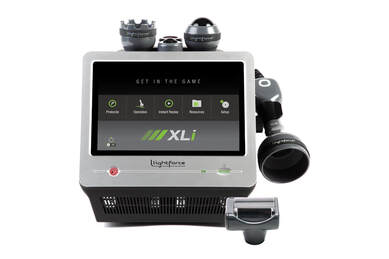
HIGH-POWER PHOTOBIOMODULATION THERAPY
Effects of the Lightforce XLi laser:
1. Anti-Inflammation
Laser therapy has an anti-edemic effect as it causes vasodilation, but also because it activates the lymphatic drainage system to drain swollen areas. As a result, there is a reduction of excess tissue fluid.
2. Anti-Pain (Analgesic)
Laser therapy has a marked beneficial effect on nerve cells which block pain transmitted to the brain. This decreases nerve sensitivity. Also, due to less inflammation, there is less edema and less pain. Another pain-blocking mechanism involves the production of high levels of pain-killing chemicals such as endorphins and enkephalins from the brain and adrenal glands.
3. Accelerated Tissue Repair And Cell Growth
Lasers penetrate deeply into tissue and accelerate cellular reproduction and growth. This increases the energy available to the cell so that the cell can take on nutrients faster and get rid of waste products. As a result, cells are repaired faster.
4. Improved Vascular Activity
The laser increases the formation of new capillaries in damaged tissue and increases vessel diameter. This accelerates the healing process, closes wounds quickly, and reduces scar tissue.
5. Increased Metabolic Activity
Laser therapy creates higher outputs of specific enzymes and greater oxygen loads for blood cells.
6. Trigger Points and Acupuncture Points
Laser therapy stimulates muscle trigger points and acupuncture points on a non-invasive basis, providing musculoskeletal pain relief.
7. Reduced Fibrous Tissue Formation
Laser therapy reduces the formation of scar tissue following tissue damage from injury or surgery.
8. Improved Nerve Function
Damaged nerves can result in numbness and impairment. Laser speeds nerve regeneration and increases the amplitude of nerve signals to optimize recovery.
9. Immune System
Laser has a direct effect on immunity status by stimulation of immunoglobulins and lymphocytes. Laser is absorbed by chromophores (molecular enzymes). ATP production is enhanced, which is the source of cell energy and the energy source for all chemical reactions in the cells.
10. Faster Wound Healing
The laser stimulates fibroblast activity. Fibroblasts produce collagen, which is the essential protein required to replace or repair injured tissue. As a result, laser therapy is effective on open wounds and burns. Just like light interacts with plants in photosynthesis, laser photons interact with our cells to produce remarkable results.
Effects of the Lightforce XLi laser:
1. Anti-Inflammation
Laser therapy has an anti-edemic effect as it causes vasodilation, but also because it activates the lymphatic drainage system to drain swollen areas. As a result, there is a reduction of excess tissue fluid.
2. Anti-Pain (Analgesic)
Laser therapy has a marked beneficial effect on nerve cells which block pain transmitted to the brain. This decreases nerve sensitivity. Also, due to less inflammation, there is less edema and less pain. Another pain-blocking mechanism involves the production of high levels of pain-killing chemicals such as endorphins and enkephalins from the brain and adrenal glands.
3. Accelerated Tissue Repair And Cell Growth
Lasers penetrate deeply into tissue and accelerate cellular reproduction and growth. This increases the energy available to the cell so that the cell can take on nutrients faster and get rid of waste products. As a result, cells are repaired faster.
4. Improved Vascular Activity
The laser increases the formation of new capillaries in damaged tissue and increases vessel diameter. This accelerates the healing process, closes wounds quickly, and reduces scar tissue.
5. Increased Metabolic Activity
Laser therapy creates higher outputs of specific enzymes and greater oxygen loads for blood cells.
6. Trigger Points and Acupuncture Points
Laser therapy stimulates muscle trigger points and acupuncture points on a non-invasive basis, providing musculoskeletal pain relief.
7. Reduced Fibrous Tissue Formation
Laser therapy reduces the formation of scar tissue following tissue damage from injury or surgery.
8. Improved Nerve Function
Damaged nerves can result in numbness and impairment. Laser speeds nerve regeneration and increases the amplitude of nerve signals to optimize recovery.
9. Immune System
Laser has a direct effect on immunity status by stimulation of immunoglobulins and lymphocytes. Laser is absorbed by chromophores (molecular enzymes). ATP production is enhanced, which is the source of cell energy and the energy source for all chemical reactions in the cells.
10. Faster Wound Healing
The laser stimulates fibroblast activity. Fibroblasts produce collagen, which is the essential protein required to replace or repair injured tissue. As a result, laser therapy is effective on open wounds and burns. Just like light interacts with plants in photosynthesis, laser photons interact with our cells to produce remarkable results.
